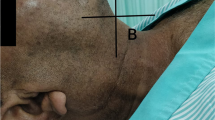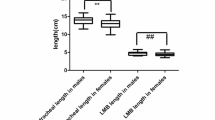Abstract
Background
No studies have been conducted to define the lengths of the upper airway’s different segments in normal healthy adults.
Aims/Objectives
This study aimed to determine the length of the subglottis and extrathoracic trachea and the factors affecting it.
Material and methods
This was an observational retrospective review study. Included 102 adult patients who underwent CT scan during the quiet inspiration phase of the upper airway.
Results
The results revealed significant positive linear relationships between height and both anterior and posterior subglottic measurements (p < 0.001). Additionally, a statistically significant, moderately strong negative correlation between age and extrathoracic tracheal measurements (p > 0.001) was observed. Men exhibited longer anterior (p < 0.001) and posterior (p > 0.001) subglottic measurements. In both sexes, the average length of the anterior subglottis was 14.16 (standard deviation [SD]: 2.72) mm, posterior subglottis was 14.51 (SD: 2.85) mm and extrathoracic trachea was 66.37 (SD: 13.71) mm.
Conclusion and significance
We concluded that a normal healthy adult’s anterior subglottis length is 6.3–19.3 mm (mean: 14.16 [SD: 2.72] mm), posterior subglottis length is 6.1–20.0 mm (mean: 14.51 [SD: 2.85] mm) and extrathoracic trachea length is 25.2–98.5 mm (mean: 66.37 [SD: 13.71] mm). Age, height and sex affected the upper airway length.





Similar content being viewed by others
Data availability
The study’s supporting data can be obtained upon request from the study’s corresponding author. Due to restrictions on information that would adversely impact the research participants’ privacy, the data are not publicly available.
References
Kutta H, Steven P, Paulsen F (2007) Anatomical definition of the subglottic region. Cells Tissues Organs 184(3–4):205–214. https://doi.org/10.1159/000099628
Mete A, Akbudak İH (2018) Functional anatomy and physiology of airway. In: Erbay R (ed) Tracheal intubation. IntechOpen, London. https://doi.org/10.5772/intechopen.77037
Reidenbach MM (1998) Subglottic region: normal topography and possible clinical implications. Clin Anat 11(1):9–21. https://doi.org/10.1002/(SICI)1098-2353(1998)11:1%3c9::AID-CA2%3e3.0.CO;2-R
Alsufyani N, Flores-Mir C, Major P (2012) Three-dimensional segmentation of the upper airway using cone beam CT: a systematic review. Dentomaxillofac Radiol 41(4):276–284. https://doi.org/10.1259/dmfr/79433138
Brown BM, Oshita AK, Castellino RA (1983) CT assessment of the adult extrathoracic trachea. J Comput Assist Tomogr 7(3):415–418. https://doi.org/10.1097/00004728-198306000-00005
Bryce DP (1975) The laryngeal subglottis. J Laryngol Otol 89(7):667–685. https://doi.org/10.1017/S0022215100080890
Cherng CH, Wong CS, Hsu CH, Ho ST (2002) Airway length in adults: estimation of the optimal endotracheal tube length for orotracheal intubation. J Clin Anesth 14(4):271–274. https://doi.org/10.1016/S0952-8180(02)00355-0
Connor S (2007) Laryngeal cancer: how does the radiologist help? Cancer Imaging 7(1):93–103. https://doi.org/10.1102/1470-7330.2007.0010
Coordes A, Rademacher G, Knopke S, Todt I, Ernst A, Estel B, Seidl RO (2011) Selection and placement of oral ventilation tubes based on tracheal morphometry. Laryngoscope 121(6):1225–1230. https://doi.org/10.1002/lary.21752
DeGraff AC, Bouhuys A (1973) Mechanics of air flow in airway obstruction. Annu Rev Med 24(1):111–134. https://doi.org/10.1146/annurev.me.24.020173.000551
Enver N, Doruk C, Kara E, Asilyukesek H, Başaran B (2018) A morphometric analysis of laryngeal anatomy: a cadaveric study. Turkish J Ear Nose Throat 28(2):71–77. https://doi.org/10.5606/Tr-ENT.2018.35229
Gamsu G, Webb WR (1982) Computed tomography of the trachea: normal and abnormal. AJR Am J Roentgenol 139(2):321–326. https://doi.org/10.2214/ajr.139.2.321
Grillo HC (1965) Circumferential resection and reconstruction of the mediastinal and cervical trachea. Ann Surg 162(3):374–388. https://doi.org/10.1097/00000658-196509000-00007
Hatipoglu Z, Turktan M, Avci A (2016) The anesthesia of trachea and bronchus surgery. J Thorac Dis 8(11):3442–3451. https://doi.org/10.21037/jtd.2016.11.35
Jain M, Dhall U (2010) Morphometry of the thyroid and cricoid cartilages in adults on CT scan. J Anat Soc India 59(1):19–23. https://doi.org/10.1016/S0003-2778(10)80005-X
Jotz GP, Stefani MA, Filho OP, Malysz T, Soster PR, Leão HZ (2014) A morphometric study of the larynx. J Voice 28(6):668–672. https://doi.org/10.1016/j.jvoice.2014.03.008
Kamel KS, Lau G, Stringer MD (2009) In vivo and in vitro morphometry of the human trachea. Clin Anat 22:571–579. https://doi.org/10.1002/ca.20815
Kuo GP, Torok CM, Aygun N, Zinreich SJ (2011) Diagnostic imaging of the upper airway. Proc Am Thorac Soc 8(1):40–45. https://doi.org/10.1513/pats.201004-032RN
Shepard J, Flores E J, Abbott GF (2018) Imaging of the trachea. Ann Cardiothorac Surg 7(2):197–209. https://doi.org/10.21037/acs.2018.03.09
Prasanna Kumar S, Ravikumar A (2014) Biometric study of the internal dimensions of subglottis and upper trachea in adult Indian population. Indian J Otolaryngol Head Neck Surg 66(1):261–266. https://doi.org/10.1007/s12070-012-0477-x
Ulusoy M, Uysal II, Kivrak AS, Ozbek S, Karabulut AK, Paksoy Y, Dogan NU (2016) Age and gender related changes in bronchial tree: a morphometric study with multidedector CT. Eur Rev Med Pharmacol Sci 20(16):3351–3357
Zhou N, Ho JP, Klop C et al (2021) Intra-individual variation of upper airway measurements based on computed tomography. PLoS One 16(11):e0259739
Wong YL, KrishnanV IN, Mohamad MH (2021) Application of postmortem radiographs: advantages & disadvantages: a case report. J Clin Health Sci 6(1):52–58
Martin SE, Mathur R, Marshall I, Douglas NJ (1997) The effect of age, sex, obesity and posture on upper airway size. Eur Respir J 10(9):2087–2090. https://doi.org/10.1183/09031936.97.10092087
Mobashir MK, Abd El Raof SM, Quriba AS, Anany AM, Hassan EM (2018) Linear measurements of vocal folds and laryngeal dimensions in freshly excised human larynges. J Voice 32(5):525–528. https://doi.org/10.1016/j.jvoice.2017.08.024
Abramson Z, Susarla S, Troulis M, Kaban L (2009) Age-related changes of the upper airway assessed by 3-dimensional computed tomography. J Craniofac Surg 20:657–663. https://doi.org/10.1097/SCS.0b013e318193d521
Otoch JP, Minamoto H, Perini M, Carneiro FO, Artifon EL (2013) Is there a correlation between right bronchus length and diameter with age? J Thorac Dis 5(3):306. https://doi.org/10.3978/j.issn.2072-1439.2013.03.12
Lin H, Xiong H, Ji C et al (2020) Upper airway lengthening caused by weight increase in obstructive sleep apnea patients. Respir Res 21(272):1–10. https://doi.org/10.1186/s12931-020-01532-8
Susarla SM, Abramson ZR, Dodson TB, Kaban LB (2010) Cephalometric measurement of upper airway length correlates with the presence and severity of obstructive sleep apnea. J Oral Maxillofac Surg 68(11):2846–2855. https://doi.org/10.1016/j.joms.2010.06.196
Abramson Z, Susarla S, August M, Troulis M, Kaban L (2010) Three-dimensional computed tomographic analysis of airway anatomy in patients with obstructive sleep apnea. J Oral Maxillofac Surg 68(2):354–362. https://doi.org/10.1016/j.joms.2009.09.087
Funding
This research received no specific grant from any funding agency in the public, commercial, or not-for-profit sectors.
Author information
Authors and Affiliations
Contributions
Saleh Alqaryan, Faisal Alosaimey, Abdulaziz Alrabiah, Khaled Alhussinan, Mohammed Alyousef all collected data, established methodology, formal analysis, wrote the manuscript. Yousef Aljathlany, Abdullah Aljasser, Manal bukhari, Mohammed Almohaizea, Khalid Alqahtani, Ahmed Alammar all supervised the work and formulated research idea. Adeena Khan worked on the radiological imaging revision and figures editing All authors reviewed manuscripts
Corresponding author
Ethics declarations
Conflict of interest
The authors declare no competing interests.
Consent to participate declarations
Consent to participate was waived due to retrospective nature of the study.
Ethical approval
The study was conducted in accordance with the Declaration of Helsinki, the KSU-IRB Guidelines, The Law of Ethics of Research on Living Creatures, and the protocol was approved by the Ethics Committee of King Saud University with IRB Project No. E-19-4394.
Additional information
Publisher's Note
Springer Nature remains neutral with regard to jurisdictional claims in published maps and institutional affiliations.
Rights and permissions
Springer Nature or its licensor (e.g. a society or other partner) holds exclusive rights to this article under a publishing agreement with the author(s) or other rightsholder(s); author self-archiving of the accepted manuscript version of this article is solely governed by the terms of such publishing agreement and applicable law.
About this article
Cite this article
Alqaryan, S., Alrabiah, A., Alhussinan, K. et al. Measurement of the lengths of different sections of the upper airway and their predictive factors. Surg Radiol Anat (2024). https://doi.org/10.1007/s00276-024-03345-6
Received:
Accepted:
Published:
DOI: https://doi.org/10.1007/s00276-024-03345-6




